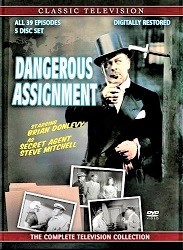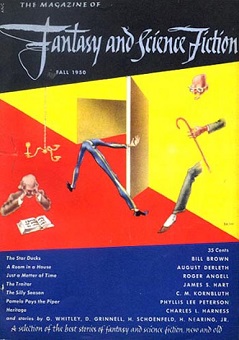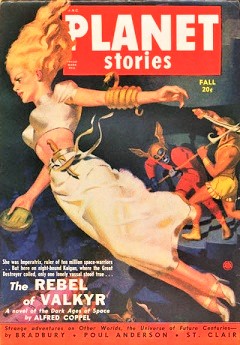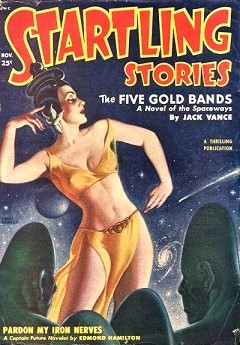
 “Yeah, danger is my assignment–I get sent to a lot of places I can’t even pronounce. They all spell the same thing, though–trouble!”
“Yeah, danger is my assignment–I get sent to a lot of places I can’t even pronounce. They all spell the same thing, though–trouble!”Dangerous Assignment (1949-1953) aired “Indochina-Sarvich Framed” on November 25, 1950 as the 39th of its estimated 167 episodes. Since this is only the third episode we have offered of Dangerous Assignment and the first in six months, a reprise of its background is in order for newcomers to the series. The show debuted on the NBC network in July of 1949 as a summer replacement and ceased in August after 7 episodes. It was popular enough with listeners and was picked up in February of 1950 to begin its almost 4-year run. It starred popular Hollywood actor Brian Donlevy (1910-1972, photo at right) as secret agent Steve Mitchell, who was sent as an undercover foreign correspondent by an unnamed U. S. State Department agency on delicate assignments abroad where U. S. interests were involved. His only “agency” contact was “the commissioner,” who would read him in on the background of the situation and then send him off to various hotspots around the globe to rectify the situation. He was rather like an early James Bond character, but much more low-key and without all the gadgets, though the situations were very much in line with some of the problems a Bond character might face.

 Dangerous Assignment proved popular enough (and through the savvy management of Donlevy himself) that it was given a television show that ran from late 1951 until May of 1952 and comprised 39 episodes (tv promo poster top left). Donlevy himself led quite an interesting life with several SF genre connections, about which more in a moment. For his role as Sergeant Markoff in 1939’s Beau Geste he was nominated for a Best Supporting Acting Oscar, but lost. His career spanned the decades of the 1930s-1960s in both motion pictures (over 80 films), and television, where he played both good and bad characters in numerous popular shows. As to Donlevy’s pre-radio and film careers, in 1916 he answered the Wisconsin Army National Guard’s call to join the Pancho Villa Expedition, and though he was only 14 and lied about his age, he was accepted and served as a bugler. And during World War I he ended up in France with Company C, 127th Infantry Regiment, which was a part of the 32nd Infantry Division.
Dangerous Assignment proved popular enough (and through the savvy management of Donlevy himself) that it was given a television show that ran from late 1951 until May of 1952 and comprised 39 episodes (tv promo poster top left). Donlevy himself led quite an interesting life with several SF genre connections, about which more in a moment. For his role as Sergeant Markoff in 1939’s Beau Geste he was nominated for a Best Supporting Acting Oscar, but lost. His career spanned the decades of the 1930s-1960s in both motion pictures (over 80 films), and television, where he played both good and bad characters in numerous popular shows. As to Donlevy’s pre-radio and film careers, in 1916 he answered the Wisconsin Army National Guard’s call to join the Pancho Villa Expedition, and though he was only 14 and lied about his age, he was accepted and served as a bugler. And during World War I he ended up in France with Company C, 127th Infantry Regiment, which was a part of the 32nd Infantry Division.
 As to Donlevy’s SF connections, there are two worthy of interest. He played the lead role of Professor Bernard Quatermass in the 1955 British film The Quatermass Xperiment (retitled as The Creeping Unknown in the U. S.), then reprised his role as Professor Quatermass in the 1957 British sequel Quatermass 2 (retitled as Enemy from Space in the U. S.). As to his second genre connection of note, it has to do with iconic early horror actor Bela Lugosi (1882-1956). It would seem that our Bela was either a ladies man or had trouble keeping them, for he was married five times. The total elapsed time of his marriage to four of his wives was a mere 8 years. The marriage to his fourth wife, however, was to be for 20 years to Lillian Arch. Lillian Arch (1911-1981) was 19 when they married, Bela was 51. They remained married from 1933-1953, at which time they divorced. A partial reason given for the divorce was Bela’s jealousy of Lillian’s close friendship with none other than Brian Donlevy, with whom Lillian worked on both the radio and television programs as a full-time assistant. Bela’s jealousy, warranted or not, ten years after Bela’s death in 1956, Brian would marry Lillian, the fourth ex-Mrs. Bela Lugosi. They would remain married until Donlevy’s death in 1972.
As to Donlevy’s SF connections, there are two worthy of interest. He played the lead role of Professor Bernard Quatermass in the 1955 British film The Quatermass Xperiment (retitled as The Creeping Unknown in the U. S.), then reprised his role as Professor Quatermass in the 1957 British sequel Quatermass 2 (retitled as Enemy from Space in the U. S.). As to his second genre connection of note, it has to do with iconic early horror actor Bela Lugosi (1882-1956). It would seem that our Bela was either a ladies man or had trouble keeping them, for he was married five times. The total elapsed time of his marriage to four of his wives was a mere 8 years. The marriage to his fourth wife, however, was to be for 20 years to Lillian Arch. Lillian Arch (1911-1981) was 19 when they married, Bela was 51. They remained married from 1933-1953, at which time they divorced. A partial reason given for the divorce was Bela’s jealousy of Lillian’s close friendship with none other than Brian Donlevy, with whom Lillian worked on both the radio and television programs as a full-time assistant. Bela’s jealousy, warranted or not, ten years after Bela’s death in 1956, Brian would marry Lillian, the fourth ex-Mrs. Bela Lugosi. They would remain married until Donlevy’s death in 1972.
The title of this episode follows the format of all the others in the series, in that it begins with a country or part of the world in which the story takes place, and then provides a key to that specific episode. Thus, here we have “Indochina–Sarvich Framed.” Our secret agent Steve Mitchell is sent by the unnamed commissioner of the unspecified U. S. Government Agency to French Indochina to retrieve one of our own–agent Sarvich–being held prisoner by a band of guerrilla fighters in the First Indochina War (1946-54), also known as the Anti-French Resistance War if you were on the side of the guerrillas. The war would continue for several more years and eventually morph into what became known as the Vietnam War. Sarvich had been framed as a traitor but now new evidence has come to light that he was framed, and thus hangs the tale and why we need to get him safely back in U.S. hands. And it isn’t easy as Mitchell finds out, his efforts and those of others leading to much violence and death–a truly dangerous assignment.
Play Time: 28:50
{Still eating leftovers from Thanksgiving two days prior to this episode airing, Saturday afternoon found the neighborhood gang walking to the corner newsstand thankful they lived in the midwest, for on this date in 1950 the “storm of the century” hit the east coast of the United States, killing hundreds and leaving in its wake millions of dollars in damages. Thankful, too, for the newly restocked magazine shelves covering almost an entire wall of the store, their choices were easy ones this visit. Fantasy and Science Fiction (1949-present) was starting to show a different face from the pulp covers of the past, and with this, its 4th issue, one of the gang thought he’d take a chance on this new magazine. He chose a good issue, for it contained what would become a classic, C. M. Kornbluth’s “The Silly Season.” F&SF would go from a quarterly to a bi-monthly with its next issue, cover dated December 1950. Both Planet Stories and Startling Stories were mainstays for SF fans and authors during the Golden Age of the pulp magazines. Both saw their first issues in 1939 and both would end in 1955. While not the top markets, they nevertheless managed to print many now-classic stories within their pages, withness the names across the bottom of the Planet Stories issue below (Ray Bradbury, Poul Anderson, and Margaret St. Clair), and the cover story for Startling Stories with Jack Vance’s memorable “The Five Gold Bands.” 1950 saw Planet Stories as a quarterly and Startling Stories as a bi-monthly publication.}
[Left: F&SF, Fall 1950 – Center: Planet Stories, Fall 1950 – Right: Startling Stories, November 1950]



To view the entire list of weekly Old Time Radio episodes at Tangent Online, click here.